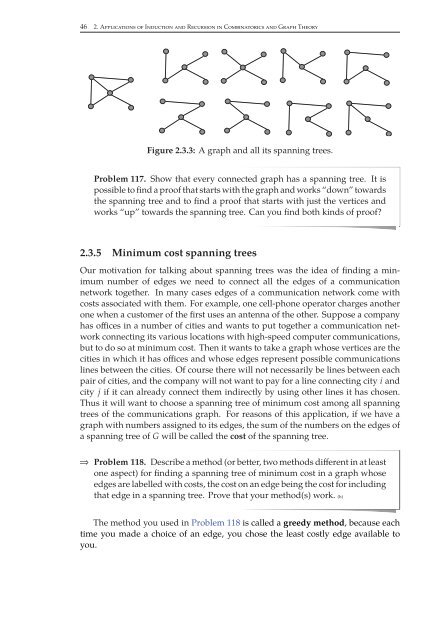Combinatorics Through Guided Discovery, 2004a
Combinatorics Through Guided Discovery, 2004a
Combinatorics Through Guided Discovery, 2004a
You also want an ePaper? Increase the reach of your titles
YUMPU automatically turns print PDFs into web optimized ePapers that Google loves.
46 2. Applications of Induction and Recursion in <strong>Combinatorics</strong> and Graph Theory<br />
Figure 2.3.3: A graph and all its spanning trees.<br />
Problem 117. Show that every connected graph has a spanning tree. It is<br />
possible to find a proof that starts with the graph and works “down” towards<br />
the spanning tree and to find a proof that starts with just the vertices and<br />
works “up” towards the spanning tree. Can you find both kinds of proof?<br />
2.3.5 Minimum cost spanning trees<br />
Our motivation for talking about spanning trees was the idea of finding a minimum<br />
number of edges we need to connect all the edges of a communication<br />
network together. In many cases edges of a communication network come with<br />
costs associated with them. For example, one cell-phone operator charges another<br />
one when a customer of the first uses an antenna of the other. Suppose a company<br />
has offices in a number of cities and wants to put together a communication network<br />
connecting its various locations with high-speed computer communications,<br />
but to do so at minimum cost. Then it wants to take a graph whose vertices are the<br />
cities in which it has offices and whose edges represent possible communications<br />
lines between the cities. Of course there will not necessarily be lines between each<br />
pair of cities, and the company will not want to pay for a line connecting city i and<br />
city j if it can already connect them indirectly by using other lines it has chosen.<br />
Thus it will want to choose a spanning tree of minimum cost among all spanning<br />
trees of the communications graph. For reasons of this application, if we have a<br />
graph with numbers assigned to its edges, the sum of the numbers on the edges of<br />
a spanning tree of G will be called the cost of the spanning tree.<br />
⇒<br />
Problem 118. Describe a method (or better, two methods different in at least<br />
one aspect) for finding a spanning tree of minimum cost in a graph whose<br />
edges are labelled with costs, the cost on an edge being the cost for including<br />
that edge in a spanning tree. Prove that your method(s) work. (h)<br />
The method you used in Problem 118 is called a greedy method, because each<br />
time you made a choice of an edge, you chose the least costly edge available to<br />
you.


















